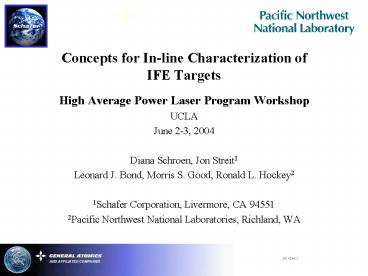Concepts for In-line Characterization of IFE Targets - PowerPoint PPT Presentation
1 / 16
Title:
Concepts for In-line Characterization of IFE Targets
Description:
Shells Flow Through Tube. Analysis (2 Views Minimum) DS 6/2/04 5 ... Use multiple on-line technologies to give rapid go/no-go sorting ... – PowerPoint PPT presentation
Number of Views:23
Avg rating:3.0/5.0
Title: Concepts for In-line Characterization of IFE Targets
1
Concepts for In-line Characterization of IFE
Targets
- High Average Power Laser Program Workshop
- UCLA
- June 2-3, 2004
- Diana Schroen, Jon Streit1
- Leonard J. Bond, Morris S. Good, Ronald L.
Hockey2 - 1Schafer Corporation, Livermore, CA 94551
- 2Pacific Northwest National Laboratories,
Richland, WA
2
The GA Plant Design Did Not Specify When
Characterization Would Occur.
Oil Exchange
A
Isopropanol Exchange
Heat Curing
Overcoating
Micro-encapsulation
Isopropanol Exchange
CO2 Drying
Tritium Filling
B
3
- Statistical sampling was assumed. This could be
problematic because - Statistics may not be valid for all processes.
For example, variation within microencapsulation
batches is the norm. - Consequences may be difficult to deal with the
chamber conditions will be very different after a
dud than after a fire. - Instead, consider in-line automated every capsule
characterization especially at points A and B. - This is the approach that PNNL is using for the
TRISO fuel pellet.
4
Point A Characterization
- Characterizing a bare foam 4 mm OD capsule.
- 300 micron DVB Foam Wall,
- 20 - 120 mg/cc density
- QA at this point reduces useless effort in
overcoating step. - Less solvent waste from overcoating process
- Less difficult analysis as results are not
confused by overcoating. - Two possible techniques same principle.
5
A1 Optical Characterization
- Optical Characterization requires several process
steps and creates much solvent waste.
- Benzyl Salicylate is an effective index match
making characterization easier and more accurate. - DBP Dibutyl Phthalate, IPA Isopropyl Alcohol,
BSA Benzyl Salicylate
6
A2 Ultrasonic Characterization
- Ultrasonic waves couple well in 60C aqueous
solutions. - No exchanges would be required.
- Non-contact Go/No Go Analysis.
Ultrasonic Transducer
Measured Interfaces Thicknesses
Profile of Focused Field
7
Point B Characterization
- Characterization of a completed target.
- QA at this point reduces failure rate in the
chamber. - With a shot rate of 500,000 per day even a
small percentage of failures is a large number. - The concept is to do multiple characterizations
to improve the probability of detecting defects.
- Wall, CH Au
- DVB foam
- DT ice layer
8
B1 Ultrasonic Characterization
- High Speed
- Non-Contact
- Liquid Helium is Used as Ultrasonic Couplant
- Target is Inspected on-line using suite of
Ultrasonic Transducers - Pulse-echo (one transducer)
- Transmission (pair)
- Real-time data processing
- Unacceptable Targets are Ejected
9
B2 EM In-Line Characterization
Throughput Up to 200 particle/sec
Electric Field (Dielectric Constant)
Eddy Current (Conductivity Permeability)
QA/QC Meter
10
Development of Cryogenic Measurement Concept
- Measured Properties
- Concentricity, Thickness of Deuterium Ice Layer
- Detection and Quantification of Non-Bond Regions
or Voids - Detailed Imaging of Internal Structure
The proof of cryogenic ultrasonic
characterization can be done now.
Heat Shield
Heat Shield
Heat Shield
Properties of Cryogenic Fluids Fluid Acoustic
Temp. Relative Velocity
Attenuation (m/s) (K) Water
1480 298 22 Nitrogen 860 77 14
Neon 600 27 23 Helium 227 2 70 Helium 238
0.4 2
Acoustic Transducer
Acoustic Transducer
Acoustic Transducer
Cryogenic Liquid
Cryogenic Liquid
Cryogenic Liquid
Sample
Sample
Sample
Support Frame
Support Frame
Support Frame
Dewar
Dewar
Dewar
11
PNNL is Automating QA/QC of Coated Fuel Particle
- Gen IV reactors require TRISO coated fuel
particles. - Developing and maintaining the TRISO coating
process requires characterization of each
constituent material. - Production must be 200 particles/sec to sustain
each reactor with the 109s of particles required
at refueling. - Present day QA/QC cannot meet these challenges.
- Automated NDE methods are being developed.
- High-speed electrical, optical, ultrasonic and
X-ray methods.
R. Hockey, L.J. Bond, C. Batishko, J.N. Gray,
J. Saurwein, and R. Lowden, Advances in
Automated QA/QC for TRISO Fuel Particle
Production, Proceedings of ICAPP 04,
Pittsburgh, PA USA, June 13-17, 2004 Paper 4213
The DOE-NERI Program is supporting this work
involving a research team lead by the Pacific
Northwest National Laboratory, with collaborators
at General Atomics, Iowa State University and Oak
Ridge National Laboratory.
12
Their Concept Is to Use Multiple Techniques.
Completed targets
Reject
Optical
- Sorting technology options
- Optical
- Ultrasonic
- Electromagnetic
- Use multiple on-line technologies to give rapid
go/no-go sorting - Increase reliability of defect detection (POD)
Reject
Ultrasound
Reject
Electromagnetic
ACCEPT
13
TRISO Fuel EM In-Line Characterization Concept
800-950 µm
Throughput 200 particle/sec
Electric Field (Dielectric Constant)
Eddy Current (Conductivity Permeability)
QA/QC Meter
14
EC Signal vs. Dimensions,Normal TRISO Thin SiC
Layer
- Dimensions determined by X-ray analysis.
- EC signal is affected primarily by conductivity
volume of each material
15
Capacitance of TRISO Particles with SiC Present
(5) Absent (12)
- Fully coated, variable diameter particles to
left. - Minus SiC layer, variable diameter particles to
right. - Eddy current and electric field measurement
compared for each particle.
Normal TRISO
Missing SiC
16
Conclusions
- Advanced inspection technologies provide
potential to give on-line accept/reject for
targets at multiple points in the creation of the
target. - This eliminates the assumption of statistical
sampling. - Characterization can be done at cryogenic
temperatures when required. - At the critical point before injection, multiple
characterizations can improve probability of
fielding a good target. - Proposed technologies have history of successful
application, currently being developed for TRISO
fuel particles.































